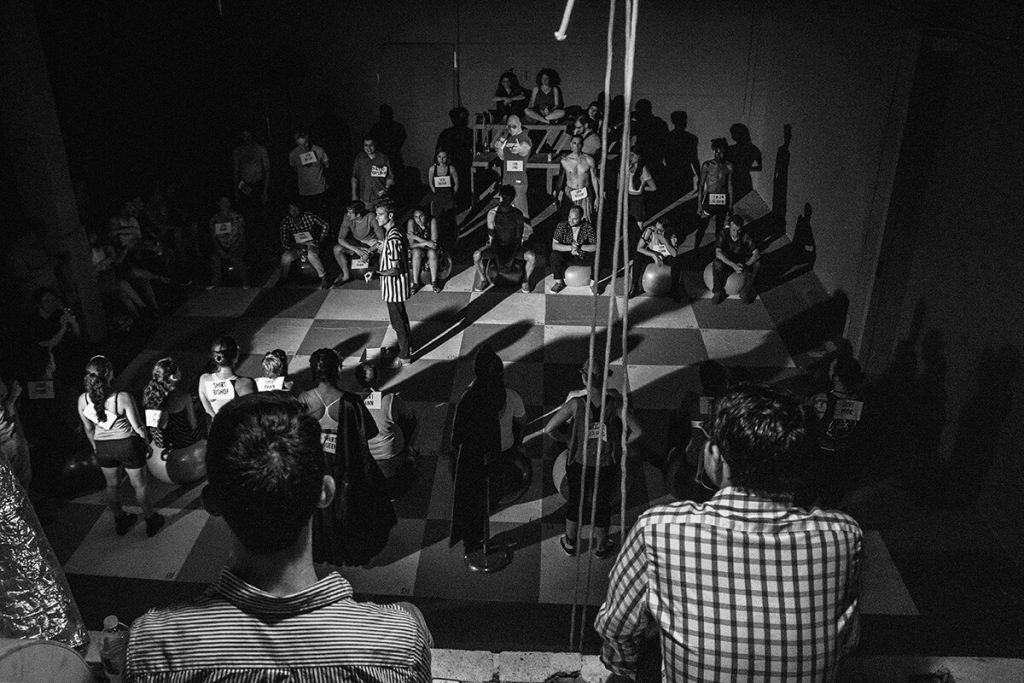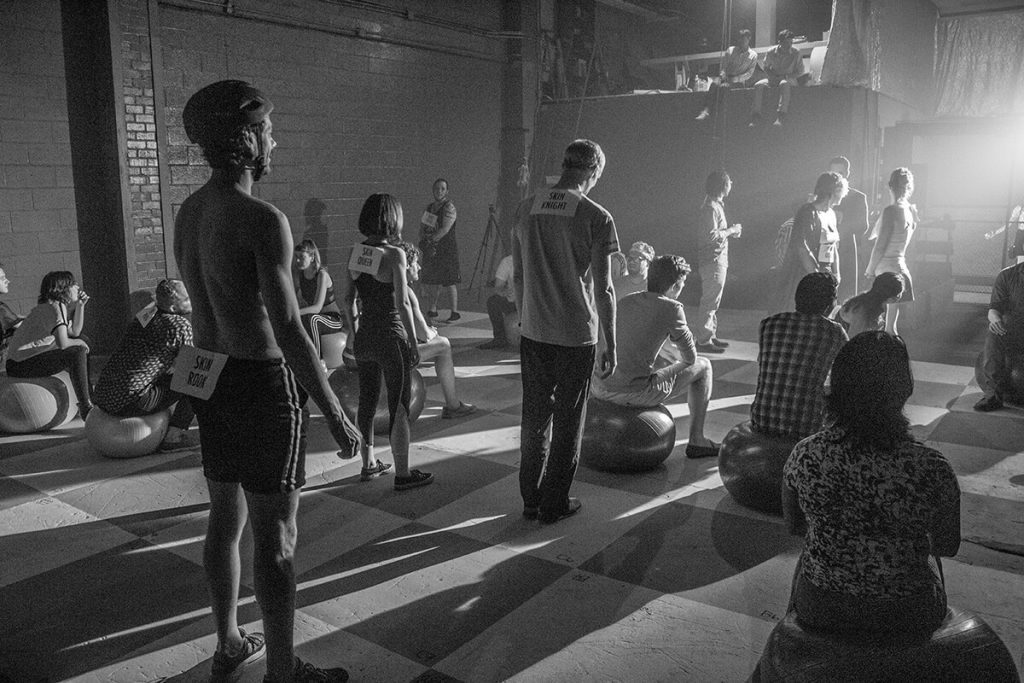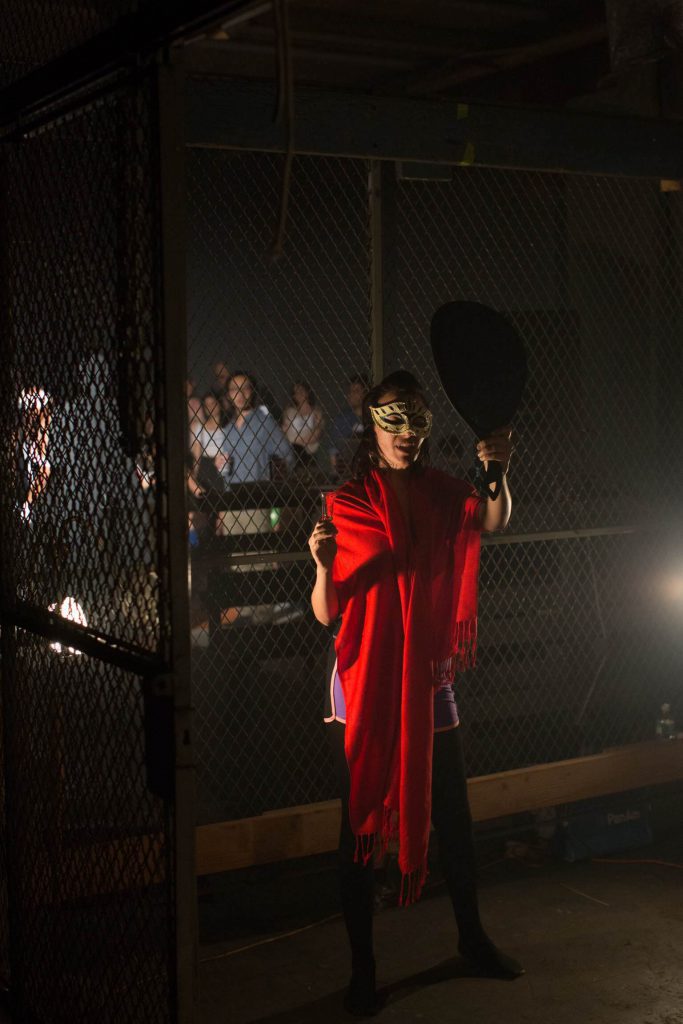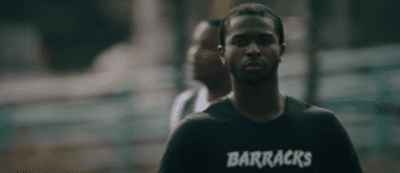Hamlet-Worthy Human Chess Game Debuts in Gowanus


Human chess at The Space warehouse in Gowanus c/o Zev Rector
This past Saturday, a human chess game unfolded on a life-sized, orange and white chess board that had been painted onto a warehouse floor. A spotlight aimed at the board illuminated the two teams, Skins and Shirts: some young, some older, some professional actors, some bystanders that had just been pulled into the match. Two expert chess players, Kyron Griffiths and Venkat Iyer, surveyed the scene from their perch at least twelve feet above the board. It looked like one of them had cracked a beer, but it was hard to tell from the bleachers.
The space is a capacious industrial building in Gowanus called Zev Rector’s Warehouse—large, raw, and tucked away behind a high metal fence that also serves to protect a pride of Mr. Frosty trucks—and the human chess pieces have been assembled here by creative duo Chelsea Hogue and Patrick Gaughan, who have been working on this project, Our Game Our Gold, since December of last year. We caught up with both recently to ask about the death sequences, The Rock, and some other curious developments.


Gaughan & Hogue ©
From the sidelines, the chess game feels like a spectator sport instead of the quiet strategy game that it usually is. The national anthem is playing loudly on a loop over the speakers, and the big brass instruments pound out each note. Gaughan wears a pinstriped, basketball referee uniform and an air of authority.
Hogue flits around the edges of the eight-by-eight square grid in a black romper, making sure that the pieces are assembled correctly: the pawns are seated on bouncy blue and green exercise balls and the queens, rooks, knights, and bishops are standing in place, dressed up in masks or dressed down as if they’ve just come from the gym. The kings are life-sized cardboard cutouts of John Turturro and Dwayne Johnson, formerly ‘The Rock’ of WWF/E fame.
At the start of the game, Gaughan gives the crowd a run-down of the rules and introduces Griffiths and Iyer. “I announced them with their height and their weight,” Gaughan explains during a telephone conversation. “It was delivered more like a wrestling match or kind of a large scale sporting event. It was this idea that we were trying push that was the climax.” The game wouldn’t simply come to an end: Griffiths and Iyer were going to rumble, and pieces were going to die and die again.
“There’s this idea that sport and death are separate,” adds Gaughan. “You lose in a sport, but that’s the worst thing that can happen. We’re all just playing a game. But how do you up the ante of that? We decided to use the idea that the performance is death. The performers are constantly dying before our eyes.”
So when Griffiths calls out, “Bishop on G2 takes F3,” the human bishop piece solemnly obeys. He walks over to the knight, makes a deft motion as if twisting the knight’s neck, and assumes his new spot on the board. The crowd watches the knight walk off the board and into a giant metal cage: It’s time for the death sequence. I take a sip of my beer.


Mid-game, everyone watches a death sequence c/o Zev Rector
The knight enters the cage, and the game pauses as the whole warehouse looks on. A ticking sound comes over the speakers, timing out the sixty seconds that the knight has left before he’s dead. “Some of the chess pieces were seasoned actors, and some were audience members and people we had just kind of found who had never done anything quite like this,” explains Hogue. “It was beautiful to see what people would do in this one metal cage based on their level of experience and their interpretation of the props that were given them.” Some pieces smashed mirrors, breathed fire, protested their deaths, told socio-political jokes about Mayor de Blasio, or read aloud about sports players who had died on the field of their sport.


A piece says her farewell c/o Greg Bosse
“Dying in the performance space or in a theater space is the climax,” Gaughan says. “They get to die and deliver their death sequence—the crown jewel of acting in a way.” Hogue agrees, and adds with a laugh, “We wanted the audience to have around thirty climaxes.”
Towards the very end of game, two spectators next to me excitedly analyze the scene: only John Turturro, The Rock, and a pawn are left. Griffiths and Iyer seem unperturbed, calling out moves in a quick succession that seemingly keeps The Rock in place between two squares on one side of the board as the pawn advances on the other.
Finally, Iyer calls out—”Pawn from A7 to A8, you are now a queen”—except that Iyer’s queen is still in a state of undress from her death sequence. She quickly slips on her mask and takes her place on the board wearing a flowing skirt and white pasties. The checkmate comes a few moves later, and all the pieces return to the board as smoke fills the warehouse. A man’s voice came over the speakers, cracking around the edges with emotion.
“It was Dwayne Johnson, and it was him talking about his grandparents and who had both recently died when that clip was recorded,” says Gaughan of the voice. “His grandfather was a musician so it was him singing this song a cappella to his grandparents. We were trying to find something that The Rock had said about death. I didn’t want it to be funny. You can laugh at that if you want to, but he’s being really sincere. It straddles that line that a lot of the performance did: Is death a serious thing or are we making fun of it?”
The Warehouse is the name of Zev Rector’s Brooklyn-based studio. Aside from filmmaking & painting, the warehouse is known for its groundbreaking parties and collaborations. As the popularity of social media declines, Rector’s Warehouse is becoming a hip hangout for artists, filmmakers, musicians, and free-thinkers.
You might also like 




















